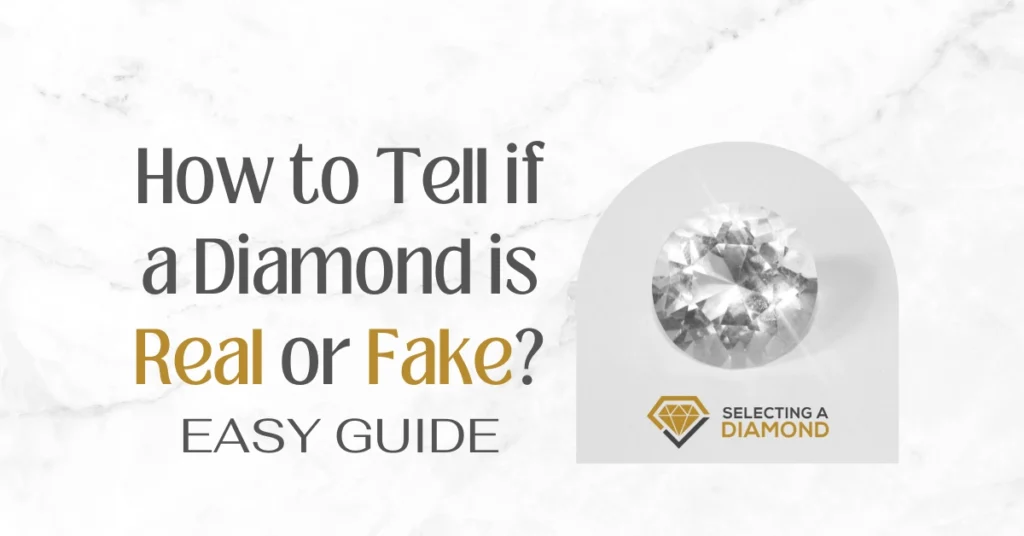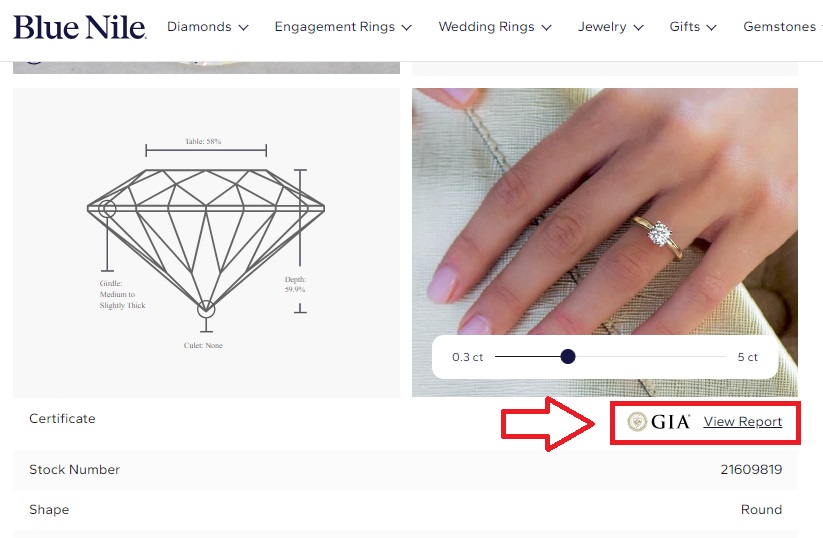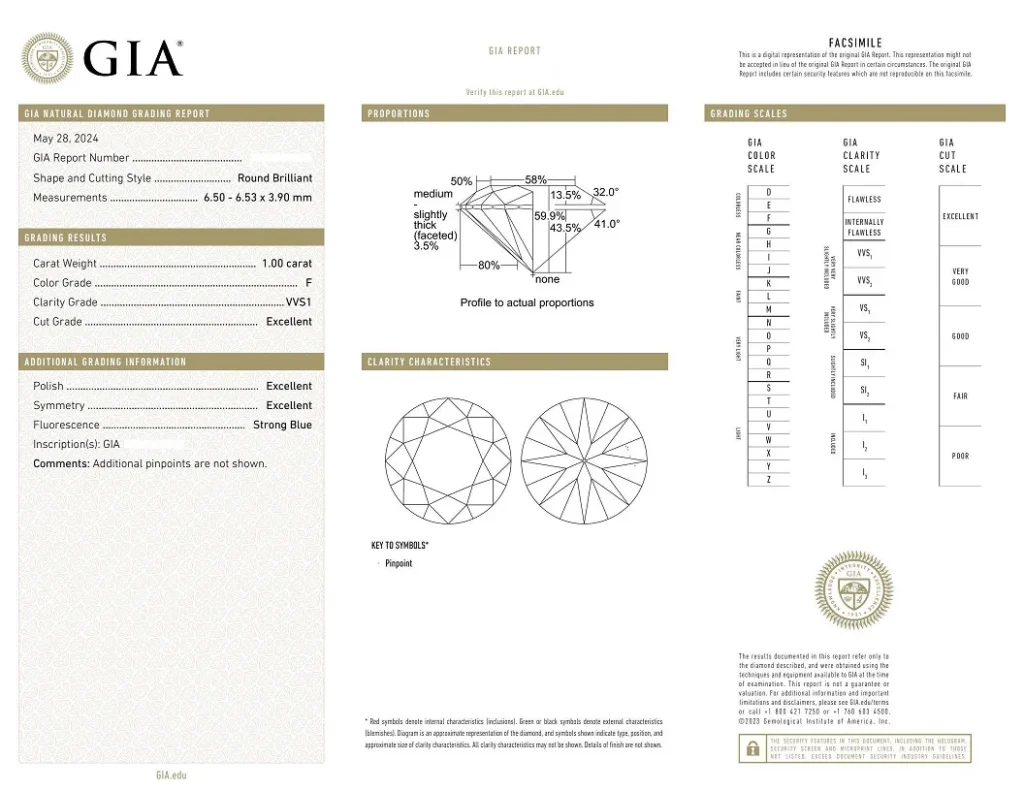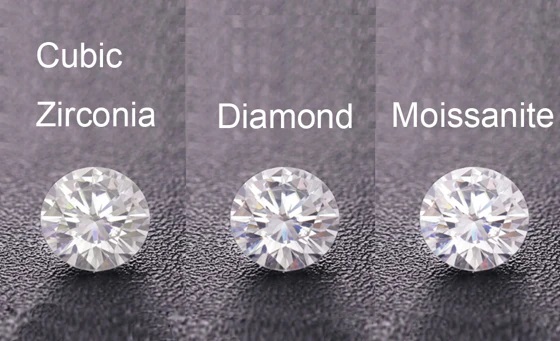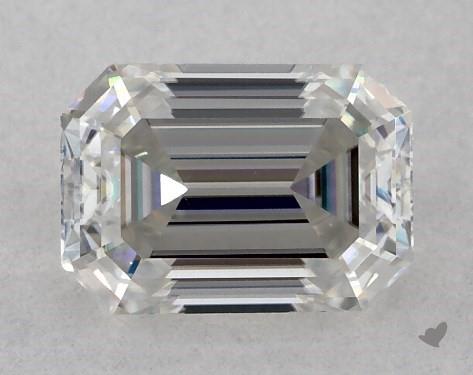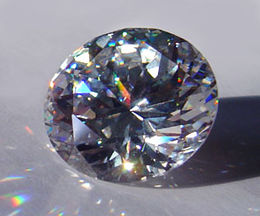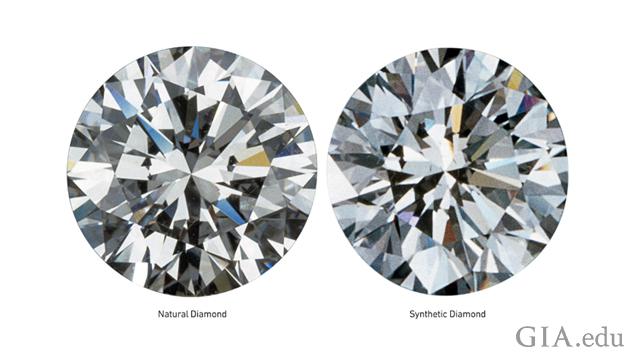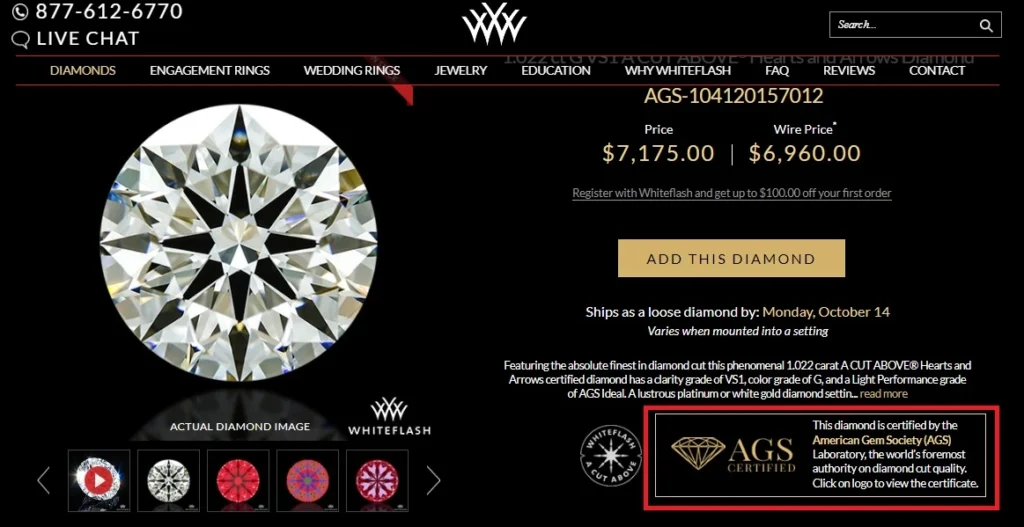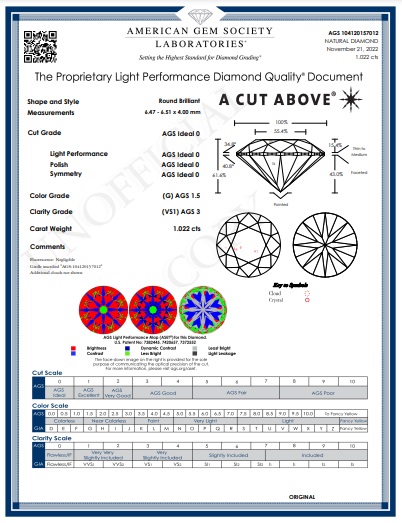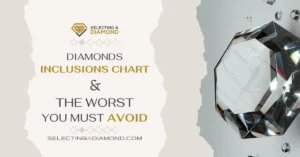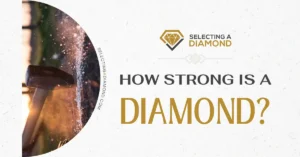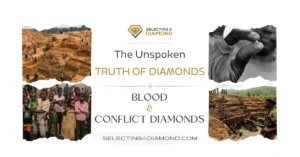We may earn a commission when you purchase through our affiliate links, at no extra cost to you. This helps support our work and allows us to continue providing unbiased, expert diamond advice.
You are wondering how to tell if a diamond is real or fake?
Well, knowing the difference can save you from making an expensive mistake when buying jewelry!
In this article:
You’ll learn several easy methods to check a diamond’s authenticity. From simple tests you can do at home to tips on what to look for when shopping, we’ll cover everything you need to know.
By the end:
You’ll feel confident in your ability to spot a genuine diamond and make smart choices when it comes to purchasing this precious gem. 👌
Spotting the Genuine: Why It’s Essential
Simply because most diamonds are expensive. So, you want to make sure you’re getting your money’s worth.
Imagine spending a lot of money on a beautiful ring, only to find out later that it’s just a shiny piece of glass!
Identifying real diamonds helps you avoid scams and ensures you’re investing in something genuine, it also means you can appreciate the quality and craftsmanship that goes into a real diamond.
Plus:
If you’re ever thinking about reselling or passing down the jewelry, knowing it’s authentic makes it much more valuable. Therefore, for all the above, it is important to tell if a diamond is real or fake.
Two Paths to Sparkle: Natural vs. Lab Diamonds
When you’re trying to tell if a diamond is real or fake, it’s important to know the difference between natural diamonds and lab-created diamonds.
-
Natural Diamonds
These are the diamonds that form deep within the Earth over millions of years! They are created from carbon under extreme heat and pressure.
Natural diamonds are unique because they carry a piece of the Earth’s history, each one is different, often with tiny flaws called inclusions that make it special.
-
Lab-Created Diamonds
These diamonds are made in a laboratory using advanced technology that mimics the natural process.
Even though they’re created in a lab, they have the same chemical composition and physical properties as natural diamonds. This means they can look just as beautiful and sparkly!
The key difference is:
That lab-created diamonds usually cost less than natural ones because they can be made more quickly and in larger quantities.
However, both types are real diamonds, so it’s essential to know what you’re looking for when buying one.
The Water Test
One simple way to tell if a diamond is real or fake is by doing the water test, this test is easy and can help you quickly check a diamond’s authenticity.
Here’s how to perform the water test:
1. Get a Glass of Water
Take a clear glass and fill it with water, about three-quarters full is perfect.
2. Drop in the Diamond
Carefully drop the diamond into the glass of water, make sure to hold it gently so you don’t accidentally drop it too hard.
3. Watch What Happens
Now, pay attention to how the diamond behaves in the water.
If the diamond sinks to the bottom, it’s likely a real diamond, real diamonds are dense, which means they will sink.
If the diamond floats or hovers near the surface, it’s probably a fake.
Many imitation stones, like cubic zirconia or glass, are less dense and tend to float.
This test is quick and can give you a good idea of whether your diamond is real or not.
Just remember:
While the water test can be helpful, it’s always a good idea to combine it with other tests and checks for the best results!
The Fog Test
Another quick way to tell if a diamond is real or fake is by doing the fog test, this simple test relies on the diamond’s ability to disperse heat, which is something real diamonds do quite well.
Here’s how to perform the fog test:
1. Breathe on the Diamond
Take the diamond and gently breathe on it, just like you would when trying to fog up a mirror, make sure you’re holding it carefully.
2. Watch What Happens
After you breathe on it, check to see how quickly the fog disappears.
If the diamond clears up quickly, it’s a good sign that it’s a real diamond, real diamonds are efficient at dispersing heat, so the fog will vanish almost instantly.
If the diamond stays foggy for a while, it may not be genuine.
Many fake stones, like glass or some cubic zirconia, don’t disperse heat as quickly, so the fog will linger longer.
Also remember:
The fog test is a helpful method, but it’s best to use it alongside other methods to confirm authenticity.
Using a Loupe or Magnifying Glass
One of the best ways to tell if a diamond is real or fake is by examining it closely with a loupe or a magnifying glass.
These tools help you see the tiny details that are hard to spot with the naked eye.
Here’s how to use a loupe or magnifying glass:
1. Get Your Tools Ready
A loupe is a small magnifying glass, often used by jewelers, if you don’t have one, a regular magnifying glass can work just fine.
2. Find a Well-Lit Area
Good lighting is key! Make sure you’re in a bright place where you can see clearly.
3. Look for Clarity
Hold the diamond in one hand and use your loupe or magnifying glass in the other, look closely at the diamond’s surface and inside.
Real diamonds often have inclusions, which are tiny flaws or specks.
These can look like small marks or lines inside the diamond, if you see inclusions, that’s a good sign it’s real!
On the other hand, if the diamond looks perfectly clear and flawless, it might not be authentic. Many fake diamonds are made to look perfect.
4. Check the Facets
While you’re examining the diamond, pay attention to the facets, the flat surfaces on the diamond, real diamonds have sharp and well-defined facets that reflect light beautifully.
If the facets look dull or uneven, it could be a fake.
It’s like being a detective 🕵️ searching for clues to uncover the truth about your diamond!
The Scratch Test
One of the coolest things about diamonds is that they are the hardest natural substance on Earth! This unique property makes them tough and scratch-resistant.
You can use this fact to help you tell if a diamond is real or fake by performing the scratch test.
To do this, follow these steps: 👇
1. Find a Hard Surface
Look for something really hard, like a piece of glass or a ceramic tile, make sure it’s something that won’t get damaged easily.
2. Gently Scratch
Take the diamond and carefully try to scratch the surface of the glass or tile, don’t press too hard, just a gentle touch is enough.
3. Check the Results
If the diamond leaves a scratch on the glass, then congratulations! 🥳 It’s likely a real diamond, real diamonds are so hard that they can scratch other materials.
If the diamond doesn’t leave any scratch, it might not be genuine.
Many imitations, like cubic zirconia or glass, are softer and won’t be able to scratch a hard surface.
Keep in mind:
Remember to be careful when doing this test, as you don’t want to damage anything in the process!
UV Light Test
Did you know that UV light can help you tell if a diamond is real or fake?
Yeb! This test is pretty simple and can reveal some interesting details about your diamond.
Let’s see how it can be done :👇
1. Get a UV Light
You can find UV lights in many stores, or sometimes even on your smartphone as a special feature, it looks like a small flashlight but gives off ultraviolet light.
2. Find a Dark Room
Turn off the lights and make sure the area is dark, this will help you see the effect of the UV light better.
3. Shine the UV Light on the Diamond
Hold the diamond under the UV light and watch what happens.
Real diamonds often glow blue under UV light, this is because they contain trace amounts of boron, which reacts to the UV rays, if your diamond shows a blue glow, that’s a good sign it’s authentic!
Fake diamonds, like glass or cubic zirconia, usually don’t show that blue glow, instead, they might appear dull or not light up at all.
Also Keep in mind:
That not all natural diamonds will glow under UV light, but many will, so this test is not definitive.
The Sparkle Test
Real diamonds have a unique way of reflecting light that makes them shine beautifully, this test is simple and fun!
Here’s how:
1. Find a Bright Light
Look for a well-lit area where you can see the diamond shine, like near a window or under bright lights.
2. Observe the Diamond
Hold the diamond in the light and move it around slowly.
Real diamonds will sparkle a lot! They reflect light in a way that creates bright flashes and a dazzling effect, you should see lots of little sparkles dancing around.
Fake diamonds, often don’t sparkle in the same way, they might look shiny, but the sparkle won’t be as brilliant.
Instead of bright flashes, you may notice a more dull or cloudy appearance.
3. Check the Surroundings
To really see the difference, try comparing your diamond to an imitation stone side by side, you’ll likely notice how the real diamond shines brighter and catches the light more effectively.
The Dot Test
This quick method helps you check the authenticity of a diamond without needing any special tools.
Steps to do: 👇
1. Find a Piece of Paper
Grab a clean, white piece of paper and draw a small dot in the center, Make sure the dot is dark enough to see clearly, like using a black pen.
2. Place the Diamond Over the Dot
Hold the diamond above the dot so that you can see both the diamond and the dot at the same time.
3. Check What You See
If you can see the dot through the diamond, it’s likely that the diamond is fake.
Many imitations, will allow you to see the dot clearly because they aren’t as refractive as real diamonds.
If you cannot see the dot clearly or if it looks blurry, you might have a real diamond.
Real diamonds have a unique way of bending light that makes it hard to see what’s behind them.
So, it doesn’t require much effort, and you can do it anywhere with just a piece of paper and a pen!
Weight Test
Another way is by performing the weight test.
Diamonds are very dense, which means they feel heavier than most other materials, even when they are small.
Here’s how you can use this to your advantage:
1. Get a Scale
If you have a small kitchen scale, that’s perfect! If not, you can also go to a jewelry store where they can weigh the diamond for you.
2. Weigh the Diamond
First, weigh the diamond on the scale, take note of the weight.
3. Compare It to Standards
To know if the weight is what you expect, you can look up the average weight for diamonds of that size.
A real diamond should be relatively heavy for its size.
For example:
A 1-carat diamond typically weighs about 0.2 grams.
4. Check for Differences
If the diamond feels lighter than expected, it could be a sign that it’s fake, many imitations, are less dense and feel lighter than real diamonds.
If it matches the expected weight, that’s a good sign,
But also keep in mind:
That weight alone isn’t a foolproof test.
Shape Test
Real diamonds come in specific shapes, and knowing what to look for can help you spot a fake.
The shape test:👇
1. Know the Common Shapes
Diamonds can be cut into various shapes, like round, princess, emerald, and oval, each shape has its own unique look.
For example:
A round diamond has a classic sparkling shape, while an emerald-cut diamond has long, rectangular facets.
2. Examine the Edges
Look closely at the edges of the diamond, real diamonds have sharp, clean edges, if you see any round or fuzzy edges, it might be a sign that the diamond is fake.
3. Check for Symmetry
A well-cut diamond will have balanced proportions.
For instance:
If you’re looking at a round diamond, all the sides should look equal, but if it appears uneven or lopsided, that’s a clue it might not be real.
4. Compare with Known Diamonds
If you have another diamond or a photo of a known real diamond of the same shape, compare the two, see if there are any major differences in how they look.
Check Setting & Mount
When you want to tell if a diamond is real or fake, checking the setting and mount is super important! The way a diamond is held in place gives you a lot of clues about its authenticity.
Why It Matters:
1. Quality of the Setting
A real diamond is usually set in high-quality materials, like gold or platinum, if the metal looks cheap or flimsy, that’s a big hint that the diamond might not be real.
Real diamonds deserve a solid, beautiful setting!
2. Craftsmanship
Take a good look at the details of the setting, a well-made setting should be neat and secure, keeping the diamond safe.
If it looks uneven or poorly put together, it could be a sign that the diamond isn’t genuine.
3. Number of Prongs
Most diamonds are held in by four or six prongs, which are like little claws that keep the diamond in place.
If there are fewer prongs or if they look weak, it might not be meant to hold a real diamond securely.
4. Type of Setting
The style of the setting also helps you determine if the diamond is real.
Some settings, like a halo or a bezel, are designed to show off the diamond’s beauty, if the setting seems odd or mismatched with the diamond, it could be a clue that it’s not genuine.
5. Look for Hallmarks
Sometimes, you can find tiny markings inside the band that tell you what metal the setting is made of, if there’s no mark, it might mean the diamond is fake or of lower quality.
Newspaper/‘Read-Through’ Effect
This test helps you see how well the diamond hides what’s behind it, which can give you clues about its authenticity.
Here’s how to do the newspaper test:
1. Grab a Newspaper
Find a newspaper or any printed paper with clear text, make sure the words are easy to read.
2. Place the Diamond on the Paper
Hold the diamond over the newspaper, make sure you can see the text clearly through the diamond.
3. Check What You See
If you can read the words clearly through the diamond, it’s a sign that it might be fake.
Real diamonds are very good at bending light, so they should distort what’s behind them, making the text look blurry or hard to read.
If the words look distorted or you can barely see them, that’s a good sign the diamond is real.
Real diamonds create a unique effect that makes it difficult to see what’s behind them clearly.
Professional Appraisal and Certification
One of the best ways to be sure a diamond is real is to have it certified by a professional gemologist.
These experts are trained to examine diamonds closely and give an official report on their quality.
Here’s why this is so important:
1. Trustworthiness
A professional appraisal helps you know that your diamond is genuine and of good quality, it’s like getting a report card for your diamond, showing how well it scores on important features like cut, color, and clarity.
2. GIA Certification
When diamonds are certified by organizations like the Gemological Institute of America (GIA), it means they have passed strict tests to confirm their quality, GIA-certified diamonds are recognized worldwide for their reliability.
3. Easy Access to Reports
Reputable online stores often provide GIA certification for their diamonds.
For instance:
Stores like James Allen and Blue Nile include a GIA-certified diamond report for each diamond they sell.
This means you can look at the report and see all the important details about the diamond right on their website.
Here is an example of what the certificate looks like👇
4. Peace of Mind
Knowing your diamond has been evaluated by a professional gives you confidence in your purchase, you won’t have to worry about whether it’s real or not, because you have proof of its authenticity.
Common Imitations
When shopping for diamonds, it’s important to know that there are some popular substitutes that can look quite similar but aren’t actually real diamonds.
Here’s a quick overview of a few common imitations:
1. Moissanite
This stone is a popular alternative to diamonds, it’s almost as hard as a diamond, which means it’s very durable.
Moissanite has a lot of sparkle and can even appear brighter than a diamond in certain lighting.
Many people choose moissanite because it’s less expensive, but it can sometimes be mistaken for a diamond if you don’t know what to look for.
2. Cubic Zirconia (CZ)
This is another common imitation that you might come across, Cubic zirconia is much cheaper than diamonds and can look pretty shiny.
However, it isn’t as hard or durable as a real diamond, so it can scratch more easily, unlike diamonds, cubic zirconia tends to have a more “glassy” appearance, which can make it look less authentic up close.
3. Synthetic Diamonds
These diamonds are created in a lab and have the same chemical composition as real diamonds, while they are real diamonds, they aren’t natural stones that formed over millions of years.
Lab-grown diamonds can be a good option, but they usually come at a lower price point.
Reputable Online Stores with Real Diamonds
When you’re looking to buy a diamond, it’s super important to choose a trusted retailer. There are several online stores that are known for selling authentic diamonds, and they make it easy to find the perfect one.
Here are a couple of reputable options:
1. James Allen
This online store is famous for its huge selection of diamonds and fine jewelry.
James Allen offers GIA-certified diamonds, which means each diamond has been carefully examined and comes with a report about its quality as mentioned above.
You can view each diamond in high-resolution images and even see 360-degree videos, so you know exactly what you’re getting.
2. Blue Nile
Another great choice is Blue Nile, which also provides a wide variety of diamonds.
They focus on quality and also offer GIA certification for their stones.
Blue Nile has a user-friendly website that allows you to filter your search by shape, size, and price, making it easier to find the perfect diamond for your needs.
3. White Flash
Known for their exceptional quality, White Flash offers a selection of diamonds that have been handpicked for their brilliance.
They also provide (AGS) American Gem Society certifications, the world’s foremost authority on diamond cut quality, ensuring that you are purchasing a real diamond.
Here is an example of what the certificate looks like👇
Their detailed descriptions and images help you make an informed choice.
Final Words About Tell if a Diamond is Real or Fake
✔ In this article, we’ve explored some important tips to help you tell if a diamond is real or fake.
✔ We learned about how to check the diamond’s characteristics, like its sparkle, shape, and setting.
✔ We also discussed fun tests you can do at home, like the water test and the dot test, which can give you clues about the diamond’s authenticity.
✔ Don’t forget the importance of professional appraisals and certifications! They provide peace of mind, ensuring you’re buying a real diamond.
✔ Plus, we talked about common imitations like moissanite and cubic zirconia, so you can spot them when shopping.
✔ When you’re ready to buy a diamond, make sure to choose reputable online stores, they offer a great selection of authentic diamonds and provide all the information you need to make the best choice.
We hope these tips will help you feel more confident about buying diamonds and make the experience more enjoyable!👋

